AFTER TREATMENT AFTER INSTALLATION OF A DAMP-COURSE BARRIER
DRYING OUT OF THE WALL
After damp-course installation, it is very important that the treated walls are left to dry for a period of several months before any re-plastering / re-rendering, painting, tuck-pointing and/or re-pointing is done. The solvent component of the damp-course material will evaporate out of the wall in the next few weeks, emitting a sweet odour that is obvious in the initial days after installation. The silicone component is left in the brickwork where it reacts with the moisture in the bricks forming a new durable plastic damp-course. During this drying out period, the rising damp salts in the brickwork (above the new damp-course) begin to migrate to the surface where they accumulate in the existing wall surface.
The period of drying varies depending on the type of wall surface present
(a) CEMENT RENDERED OR PLASTERBOARDED WALLS
Generally, it may take about a minimum 3 months of drying before any re-plastering/re-rendering can be done. Very salty walls should be left to dry for a minimum 6 months. During drying, the client should:
- remove any salt crystals which may appear on the plaster or on the brickwork behind the loose skirting boards. DO NOT allow these salts to fall between the wall and the floor. Use a brush or dry cloth.
- remove any droplets of salty water which may appear on the water repellent bricks behind the skirting boards by wiping with a slightly damp cloth. DO NOT use a damp cloth as this will re-dissolve the salt back into the brickwork.
After treatment, the walls may appear worse, that is, seem more damp. This should not cause alarm, as this is normal. The rising damp salts have migrated from the bricks on to the existing render/plaster, and it is these residual salts which absorb atmospheric moisture giving the wall a damp look and feel.
(b) PAINTED BRICK OR BARE BRICK WALLS
The drying out period is much longer as there is no poultice present on the brick surface to draw out the rising damp salts. This period can be in the order of 12 months plus. After treatment, salts will begin to migrate and appear on the surface. These should be immediately wiped away with a slightly damp cloth. This process should be performed once every 2-3 weeks until no more salt appears. If not removed, the wall will display damp patches particularly during wet and humid climate conditions. In the case of painted brickwork, it is generally necessary to strip off the old paint, clean the wall and allow sufficient drying time before any painting or plastering is to commence.
PLEASE NOTE: It is advised that no naked flames such as a gas heater, stove or fireplace, be adopted for the initial weeks after treatment as this produces a kerosene-type odour that will linger for several days.
RE-RENDERING AND RE-PLASTERING AFTER THE WALL HAS DRIED
All plaster and render contaminated with rising damp salts must be removed back to the bare bricks to a height of 350mm above the last visible signs of dampness. This refers to the removal of plaster and render above where the damp-course installation was carried out. Failure to do so will results in continual dampness in the wall, thus surface decorations will not be successful and paintwork will continue to peel off the salt contaminated surface.
SPECIFICATIONS FOR REPLASTERING AFTER THE WALL IS DRY
These specifications should be given to a qualified hard plasterer.
- Remove the old plaster and render to reveal the bare bricks to a height of 350mm (14 inches) above the last visible signs of damp. DO NOT allow this material to fall between the wall and the floor.
- Rake out and replace any salt contaminated mortar joints and remove any salts present on any exposed brickwork. Replace any very salt contaminated bricks. Wipe exposed brickwork with a slightly damp cloth at two different times to remove any residual salts, and brush off any salts that may emerge when it dries. DO NOT allow these salts to fall between the wall and the floor.
- Apply a cement render finish approximately 15mm thick (preferred cement/sand ratio 1:3) containing a waterproofing admixture. The inclusion of this admixture inhibits the migration of residual salts through the new render. Suitable admixtures include:
- Tech-Dry Salt Retarder (Tech-Dry Mortar Additive)
- Sealwall
- Fosroc
- Apply a base coat of render. When set, finish surface with hard plaster. DO NOT extend this render/plaster passed behind the skirting board, that is, batten the skirting boards away from the wall with the top of the skirting meeting the bottom of the plaster.
PLEASE NOTE:
A cheaper alternative to cement render is plasterboard. The use of this material is not encouraged as it has very little resistance to residual salts in the wall. Plasterboard should NEVER be attached directly to the brickwork. Treated pine batons or rubber-based adhesives (eg. bathroom tile adhesive) should be used.
